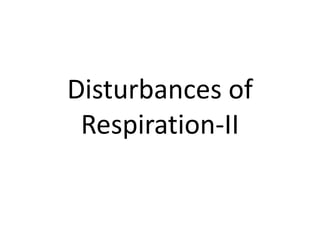Report
Share

Recommended
Recommended
More Related Content
What's hot
What's hot (20)
Deep sea physiology BY PANDIAN M. THIS PPT ONLY FIOR STUDY PURPOSE # MBBS#BD...

Deep sea physiology BY PANDIAN M. THIS PPT ONLY FIOR STUDY PURPOSE # MBBS#BD...
Deep sea diving and physiological response to high barometric pressure 

Deep sea diving and physiological response to high barometric pressure
Non respiratory functions of lung ( The Guyton and Hall physiology)

Non respiratory functions of lung ( The Guyton and Hall physiology)
Viewers also liked
Viewers also liked (20)
Control of Ventilation /Lung Physiology by Nahid Sherbini

Control of Ventilation /Lung Physiology by Nahid Sherbini
10 regulation and 11 . disturbances of respiration

10 regulation and 11 . disturbances of respiration
Similar to Disturbances of respiration 2
Similar to Disturbances of respiration 2 (20)
Abnormal Types of Breathing, Hypoxia, Cyanosis, Asphyxia

Abnormal Types of Breathing, Hypoxia, Cyanosis, Asphyxia
Abnormal types of respiration, HYPOXIA, ASPHYXIA, Cyanosis (The guyton and ha...

Abnormal types of respiration, HYPOXIA, ASPHYXIA, Cyanosis (The guyton and ha...
More from Lawrence James
More from Lawrence James (20)
Disturbances of respiration 2
- 2. Cyanosis: Definition: Cyanosis is defined as bluish coloration of skin and mucus membrane. It occurs due to the presence of large amount of reduced hemoglobin in the blood. The quantity of reduced hemoglobin should be at least 5 to 7 g% in the blood to cause cyanosis. Distribution: It is distributed all over the body, but it is more marked in certain regions where skin is thin. e.g. lips, cheeks, ear lobes, nose, fingers and base of nail.
- 3. Conditions when cyanosis occurs: Conditions which leads to hypoxic hypoxia and stagnant hypoxia. Cyanosis does not occur in anemic hypoxia and histotoxic hypoxia. Conditions when altered hemoglobin is formed.Due to poisoning, hemoglobin is altered into metemoglobin or sulfhemoglobin, which can cause cyanosis. The cyanotic discoloration is due to the dark color of the compounds. Conditions like polycythemia when red blood cell count increases, with which viscosity of blood also increases. This leads to sluggishness of the blood flow. Because of this, the quantity of deoxygenated blood is increased and color of deoxygenated blood is dark blue
- 4. Cyanosis and Anemia: Cyanosis occurs only when the quantity of reduced hemoglobin is about 5-7g%. But, in anemia the hemoglobin content itself is less. So, cyanosis cannot occur in anemia.
- 5. Asphyxia: Any condition which is characterized by combination of hypoxia and hypercapnea due to obstruction of air passage. Symptoms of Asphyxia: Stage of hyperpnea: (time 1 min) Breathing becomes deep and rapid due to the powerful stimulation of respiratory centers by excess carbon dioxide. It is followed by dyspnea and cyanosis. Eyes becomes more prominent. 2. Stage of convulsions: (time 1 min) Expiratory efforts becomes more violent Respiratory and generalized convulsions appear Heart rate increases Blood pressure increases Consciousness is lost 3. Stage of collapse: (time 3 min) Depression of centers in the brain The respiratory gasping occurs Pupils becomes dilated Heart rate is reduced All body reflexes are lost Finally the death occurs
- 6. Periodic breathing: The abnormal or uneven respiratory rhythm is called the periodic breathing. There are two types of periodic breathing: Cheyne-Stokes breathing Biot’s breathing
- 7. Features of Cheyne-Stokes Breathing: It is marked by two alternative periods: Rapid deep respiration called hyperpnea Complete stoppage of respiration called apnea Hyperpneic period: In beginning the breathing is slow. The amplitude of respiration increased gradually and reaches the maximum. Then, it decreases and reaches minimum and is followed by apnea. This effect is called waxing and waning of breathing. Apnea period: When, the force of breathing is reduced to minimum, stoppage of breathing occurs for a short period. This is again followed by hyperpneic period and the cycle gets repeated.
- 8. Conditions when Cheyne-Stokes Breathing occurs: Physiological conditions: During deep sleep In high altitude In new born babies Pathological conditions: During cardiac diseases During renal diseases In premature infants
- 9. Features of Biot’s Breathing: This is characterized by period of apnea and hyperpnea. There is no waxing and waning of breathing. Conditions when Biot’s Breathing occurs: Biot’s breathing does not occur in physiological conditions. It occurs only in pathological conditions involving nervous disorders, like in injury to the brain
- 10. Thank You
